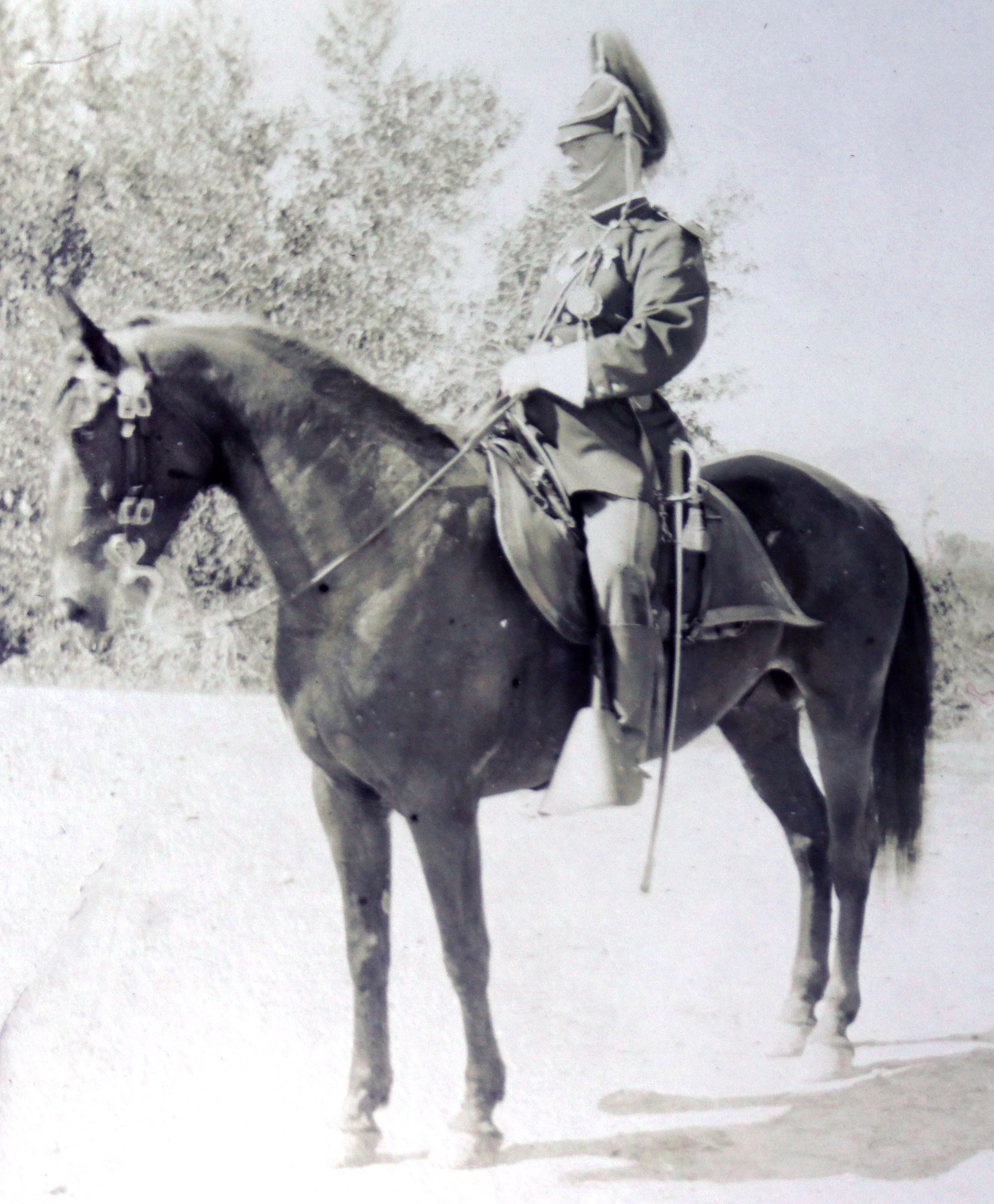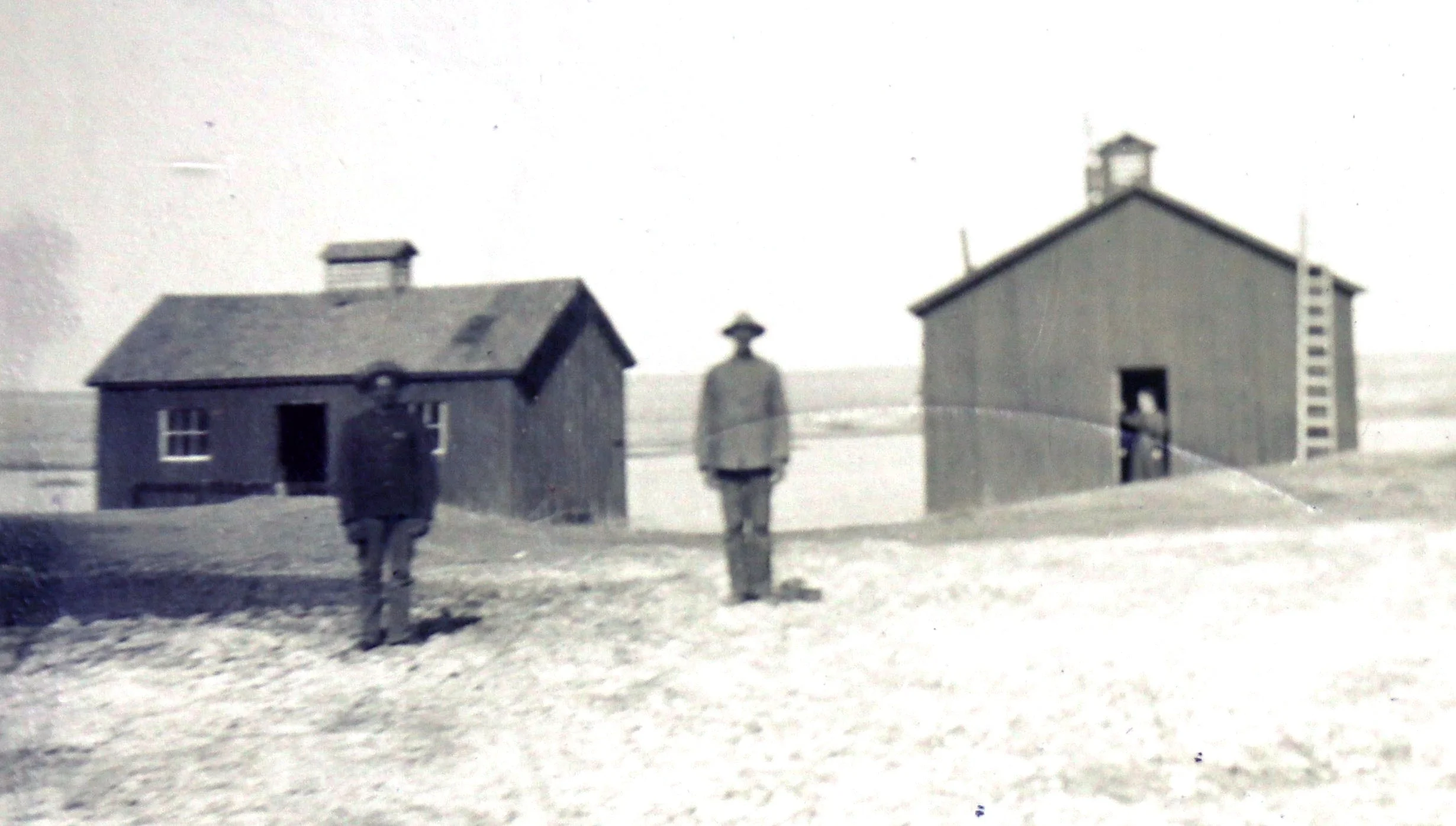The Road to Fort Washakie
One of my family’s most treasured heirlooms is a scrapbook containing photos taken between 1895 and 1897 at Fort Washakie, Wyoming. At that time, my great-great-grandfather John S. Loud was stationed there as an officer of the 9th Cavalry, one of the segregated Black cavalry regiments often called the Buffalo Soldiers. His wife, Kate Mifflin Loud, his son, James (Jim) Loud, age 19, and his daughter, my great-grandmother Dorothy (Dollie) Loud, age 16, lived at the fort with him, as they had at his previous posts on the western frontier.
Captain John S. Loud, 9th Cavalry, U.S. Army, on his favorite horse, Punch. 1895-7. Ft. Washakie, Wyoming. Photo from Loud family scrapbook.
After joining the 9th Cavalry in 1867, John S. Loud became regimental adjutant, managing correspondence, administration, and logistics. He served in this role at various regimental headquarters in Texas for the next eight years, and after the regiment moved to New Mexico in 1875, he became Acting Assistant Adjutant General for the army’s District of New Mexico, under Colonel Edward Hatch of the 9th Cavalry. In 1880, Loud was promoted to captain and given command of the 9th Cavalry’s D Troop, a position he held until shortly before he retired from the army in 1898. He was recognized as an effective leader, with relatively low rates of desertion and dishonorable discharge from his troop (Kenner 1999).
Loud’s last posting with the 9th Cavalry was in 1895 as commandant of Fort Washakie, Wyoming, the most remote military outpost in the continental United States. By this time, the efforts of Native American people to preserve their ancestral lands from white settlement were largely over. Fort Washakie, named for Chief Washakie, leader of the Eastern Shoshone people on whose land the fort had been built, had not played a major role in the plains wars, in any case. Its primary purpose was to protect the Shoshone people from more hostile Native Americans and to serve as a supply station for expeditions into the mountains around Jackson Hole, Wyoming (Frazer 1975).
The location of the fort on the Shoshone reservation promoted close contact between its residents and their Native American neighbors. As of 1894, a contributor to the Army and Navy Journal reported that “all the wood and hay and a portion of the oats required at the post for the last year have been bought from the Indians in the vicinity of the station” (“Fort Washakie” 1894). Being able to purchase locally was essential for provisioning the fort, given that freight sometimes took as much as eight weeks to be hauled from the railroad during the winter (“Fort Washakie, Wyoming” 1902).
“The Army. 9th Cavalry-Col. James Biddle.” 21 September 1895. The United States Army and Navy Journal and Gazette of the Regular and Volunteer Forces. p. 39.
In September 1895, the Loud family moved to Fort Washakie from their previous post at Fort Robinson, Nebraska Their trip started with taking the train to Casper, Wyoming. They then traveled another 170 miles on horses and in the army ambulances, also called Dougherty wagons, often used to transport officers’ wives and families. These wagons had canvas sides that could be rolled up or down and facing seats that could be folded down to make beds (Eales 1996). Dollie Loud, in a memoir of her early life, described such a journey:
Father, of course, was on horseback, with his command, but the wives and family followed in conveyances. We would start out - from what I can remember – about four o'clock in the morning. We were all in tents and we would have to get up in the morning before daylight and have breakfast and then we would have to pack and get into the conveyance and then they would sound a bugle call called 'general'. At the sound of this call, all the tents went down, whether you were in them or not. This always scared the daylights out of me; I was afraid I would be caught in our tent as it was coming down. (Longley n.d.)
Fort Washakie, at the time of the Louds’ arrival, was representative of western forts of that era. Rather than being circled by a fortified stockade, it was laid out much like a small town. There are a number of reasons why western forts were built without extensive fortifications. The lack of readily available wood was often a limiting factor, but more importantly, these forts were built to facilitate the army’s efforts to control the Native American population in the face of encroaching white settlement. This thirty-year undertaking was largely offensive, since Native American raiding parties rarely attacked larger settlements. Rather than serving defensive purposes, western forts were primarily staging grounds from which army regiments could patrol local settlements, escort stagecoaches and mail carriers, and quell Native American rebellions (Hoagland 1999).
(left) 2nd Lieutenant Guy H. Preston, 1st Lieutenant John H. Gardner, 1st Lieutenant John F. McBlain, and 2nd Lieutenant Howard R. Hickock in front of adjutant’s office. Fort Washakie. 1895-7. Photo from Loud family scrapbook.
(right) James K. Moore, post trader, in front of his home. Fort Washakie. 1895-7. Photo from Loud family scrapbook.
(left) Officers’ quarters, Fort Washakie. 1895-7. Photo from Loud family scrapbook.
(right) Post hospital, Fort Washakie. 1895-7. Photo from Loud family scrapbook.
A description of Fort Washakie, written by a contributor to the Army and Navy Journal in July 1895, a few months before the Louds arrived, stated:
The post is built of “adobe,” or sun-dried brick, and it surrounds a rectangle grassy parade 50 yards wide by 150 yards long. The parade is bordered by an avenue of fresh cottonwood trees, well-grown, and giving plenty of shade, With the long shadows of the trees thrown on the green, closely-cropped lawn of the sunlit parade, the fresh, clear streams of water running at the base of the trees, the low adobe, Spanish-looking houses with the broad piazzas, groups of officers and their ladies reclining in comfortable Japanese-looking easy chairs, or enjoying a game of tennis; sturdy looking young soldiers in trim military uniforms, entering or just leaving their barracks facing on the parade, the trumpeter sounding the various duty calls, the sentry calmly pacing up and down in front of the guard room, the great warehouses for stores, and the hospital with its pretty lawns and flower beds, all helped to make another picture (“Big Horn” 1895).
Looking at the photos above, it seems that this author has perhaps exaggerated Fort Washakie’s charms. The cottonwood trees, planted in the early 1880s by a thoughtful post quartermaster (Wheeler 1923), and the broad piazzas are there, but overall, the post looks rather barren to me.
One thing that author did get right was his description of “the great hot spring, or boiling lake, two miles below the post” (“Big Horn” 1895). This spring was the site of a bath house, enabling post residents to have hot baths even in the depths of a Wyoming winter.
Bath house at hot spring near Fort Washakie. 1895-7. Photo from Loud family scrapbook.
U.S. Army, Office of the Chief of Engineers. 1887. Ground Plan of a Bath House and Platform at Mineral Hot Springs Near Fort Washakie, Wyoming. Image from the National Archives.
Fort Washakie was a small place in 1895. It was built to accommodate nine officers and their families and three companies of enlisted soldiers. There was stabling for 100 horses and 30 mules (“Fort Washakie, Wyoming” 1902). With so few officers, each would have had to take on a number of roles such as adjutant, quartermaster, signal officer, ordnance officer, post exchange officer, and recruiting officer, on top of leading their cavalry troops. In addition to military personnel, there were some 50 or so civilian employees. These included the post trader and his family, skilled laborers such as blacksmiths, farriers, carpenters, wheelwrights, shoemakers, and tailors, and a variety of clerks, teamsters, and servants (Hoagland 1999).
I’ll write more in my next few posts about life at Fort Washakie, but this overview sets the stage for understanding the situation at the fort, where white officers and civilian employees, Black cavalrymen, members of the Eastern Shoshone people, and even a few laundrymen born in China lived side by side, somewhat uneasily balancing Victorian mores with a life far different than anyone “back East” could ever imagine.
Jim Loud, Dollie Loud, Kate Mifflin Loud, Anna Whitbread Hickok, and 2nd Lieutenant Howard R. Hickock in front of their quarters, Fort Washakie, Wyoming. 1895-7. Photo from Loud family scrapbook.
U.S. Army, Office of the Chief of Engineers. 1893. Map of Fort Washakie, Wyomin
g. Image from the National Archives.
Works Cited
“Big Horn.” 5 July 1895. “Life at Fort Washakie.” The United States Army and Navy Journal and Gazette of the Regular and Volunteer Forces. p. 747.
Eales, Anne Bruner. 1996. Army Wives on the American Frontier: Living By the Bugles. Boulder, CO: Johnson Books.
“Fort Washakie.” 10 November 1894. The United States Army and Navy Journal and Gazette of the Regular and Volunteer Forces. p. 176.
“Fort Washakie, Wyoming.” 1902. Journal of the United States Cavalry Association 13 (45): 61-5.
Frazer, Robert W. 1975. Forts of the West. Norman, OK: University of Oklahoma Press.
Hoagland, Alison K. 1999. “Village Constructions: U. S. Army Forts on the Plains, 1848-1890.” Winterthur Portfolio 34 (4): 215-237.
Kenner, Charles L. 1999. Buffalo Soldiers and Officers of the Ninth Cavalry. Norman, OK: University of Oklahoma Press.
Longley, Dorothy Loud. n.d. The Life of an Army Girl in the Far West. Unpublished manuscript.
Wheeler, Homer W. 1923. Buffalo Days: Forty Years in the Old West. Indianapolis, IN: The Bobbs-Merrill Company.










